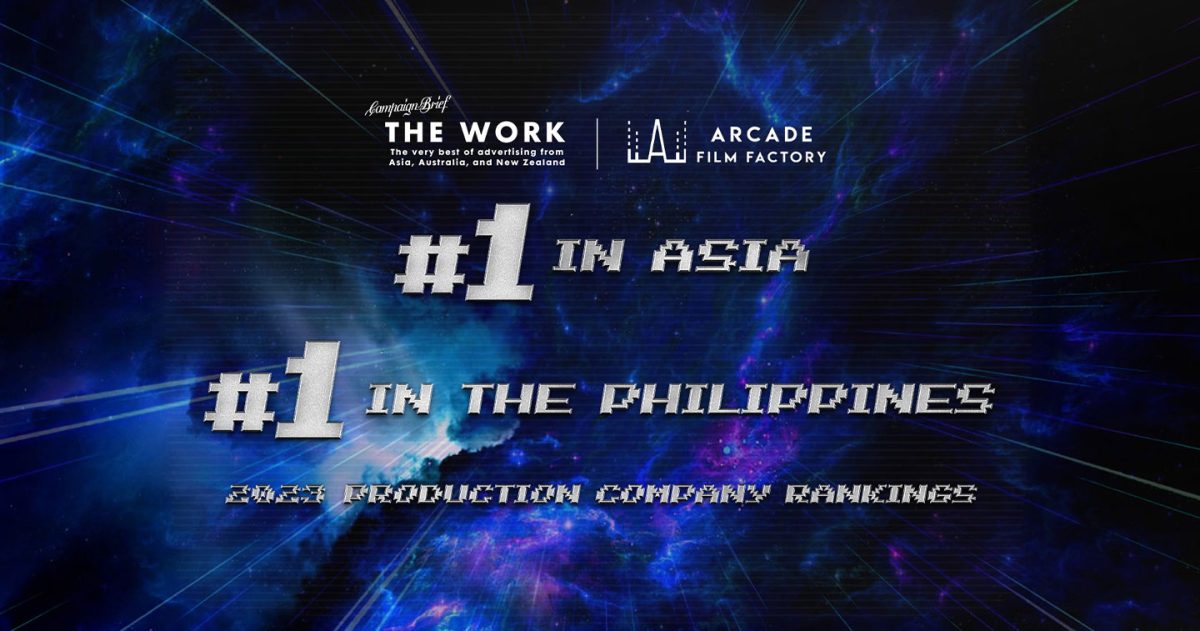MANILA, PHILIPPINES — For the first time in history, a Philippine production company has secured the number one spot among Asian production houses included in Campaign Brief Asia’s THE WORK rankings. The list, released yearly and now in its 21st year, is recognized as a true record of creativity for the entire region, featuring the very best advertising of the year from Asia, Australia, and New Zealand.
Arcade Film Factory, the award-winning production house founded in 2019 by directors Jeorge Agcaoili, Richard Ang, Nick Santiago, Mike Talampas, and Marius Talampas, was ranked this year as the number one Production Company in Asia and the number one Production Company in the Philippines. With 12 acceptances in THE WORK 2023, Arcade was also ranked the number seven Production Company in the Asia Pacific region. This was an improvement from its eight acceptances last year, which helped it rank number two in Asia, number seven in APAC, and number one in the Philippines.
Arcade’s 12 acceptances recognitions came from eight films with agencies TBWA/Singapore and GIGIL, and across eight clients like Spotify, Jollibee, MotorAce, Seaoil, GrabFood, TNT Telco, Mandaue Foam, and RC Cola.
| CLIENT | WORK | CATEGORY |
| TNT Philippines | ‘Sim Registration Campaign’ | Film/TV Craft > Direction |
| TNT Philippines | ‘Sim Registration Campaign’ | Film/TV Craft > Editing |
| TNT Philippines | ‘Sim Registration Campaign’ | Film/TV Craft > Script |
| Jollibee JolliSavers | ‘JolliSavers Campaign’ | Film/TV Craft > Editing |
| Jollibee JolliSavers | ‘JolliSavers Campaign’ | Film/TV Craft > Script |
| Seaoil | ‘Mukbang’ | Film/TV Craft > Cinematography |
| GrabFood Unlimited | ‘So Close Campaign’ | Film/TV Craft > Direction |
| Mandaue Foam | ‘Bags’ | Film/TV Craft > Direction |
| RC Cola | ‘Food Packing’ | Film/TV Craft > Sound + Music |
| RC Cola | ‘Food Packing’ | Film/TV Craft > Direction |
| Spotify | ‘#SpotifyMoments Jeepney’ | Film/TV Craft > Direction |
| MotorAce | ‘Wheels’ | Film/TV Craft > Editing |
“It’s a great honor for us in Arcade Film Factory to be ranked among the best production companies in the Asia Pacific,” said Jeorge, President and Co-founder of Arcade Film Factory. “It’s incredibly humbling to be ranked back-to-back number one Production Company in the Philippines, and finally, for the first time, number one in Asia. This recognition will inspire us to deliver even better work for our clients and agency partners.”
“We’re really grateful that stars are aligning for our growing and evolving production company that’s proudly from the Philippines,” added JM Miranda, Head of New Business at Arcade Film Factory. “Being ranked number one in Asia echoes our expansion plans to continue servicing not just clients in the Philippines, but as well as those in the Asia Pacific region in the next three years.”
View all the accepted entries of Arcade Film Factory at THE WORK: 2023 Gallery.








